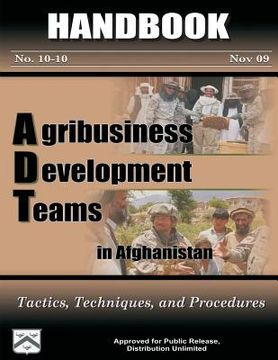Agribusiness Development Teams in Afghanistan: Tactics, Techniques, and Procedures: Handbook 10-10 (in English)
Synopsis "Agribusiness Development Teams in Afghanistan: Tactics, Techniques, and Procedures: Handbook 10-10 (in English)"
Agriculture accounts for 45% of Afghanistan's gross domestic product and is the main source of income for the Afghan economy. Over 80% of the Afghan population is involved in farming, herding, or both. However, decades of war, drought, and security challenges have devastated the country's agricultural sector, and the current level of U.S. government civilian support has been unable to keep pace with the tremendous need for assistance in this region. Revitalizing Afghanistan's agricultural sector is critical to building the government's capacity and to stabilizing the country. In 2007 the Secretary of the Army, Pete Geren; Director of the Army National Guard, Lieutenant General Clyde Vaughn; Missouri Farm Bureau President, Charles Kruse; and the Adjutant General of the Missouri National Guard, Major General King Sidwell developed an idea to deploy Soldiers with agricultural expertise and organic security capabilities to Afghanistan. They realized the development of Afghanistan's agriculture and agricultural products distribution capabilities was vital to long-term economic development and that governmental civilians (United States, Afghanistan, and other countries) and nongovernmental organizations (NGOs) were not resourced for the massive amount of work necessary in these areas as well as for the security they required. Collectively, these leaders saw the farming expertise contained within the National Guard to be the solution farming skills to grow the Afghan agribusiness economy and Soldier skills vital to operating in a counterinsurgency environment. The 935th ADT, Missouri Army National Guard (MOARNG), had the distinct honor of being the first military ADT created and deployed by the United States. The 935th ADT was comprised of Soldiers from 16 different MOARNG units. The Soldiers who volunteered for this mission not only possessed a broad spectrum of military occupational skills but also were selected based upon their civilian-acquired farming skills and agribusiness knowledge. The ADT partnered with the U.S. Department of Agriculture, the U.S. Agency for International Development, the Islamic Republic of Afghanistan, the affected Afghan provincial government, various Afghan colleges and universities, and other governmental and NGOs to maximize the use of resources, affect efficient coordination, and avoid conflict with other projects. The success of the 935th ADT was through identifying the farming deficiencies in its area of operations, obtaining funding and other resources, training and updating the agribusiness skills of the Afghan farmers and educators, and showing how to do these actions through hands-on training. The ADT's efforts included repair and maintenance of farm equipment; veterinarians to aid sick animals and provide techniques to enhance the quality and reproductive capabilities of livestock; repair and improvement of irrigation systems destroyed by decades of war; and instruction on various farming techniques for fertilizing, planting, marketing, storage, and distribution of crops. Projects and training undertaken by the ADT must be sustainable with local assets, as the ADT is only in the province for 10 to 11 months. Ideally, follow-on ADTs will deploy to back-fill the departing ADTs to continue the agribusiness training and improvements initiated by the redeploying ADTs. However, whether it is a follow-on ADT or an ADT deploying to an area for the first time, the ADTs must deploy with sufficient time available to affect the next growing season and subsequent harvest. The future of ADT service in Afghanistan is projected to diminish as civilian government agencies grow their capabilities to assist the Afghan agricultural economy reestablish itself. While this will take several years, ADTs will continue to serve U.S. and Afghan interests by helping farmers return the fertile Afghan countryside to the green and productive environment it was prior to the invasion of Soviet forces almost 40 years ag

